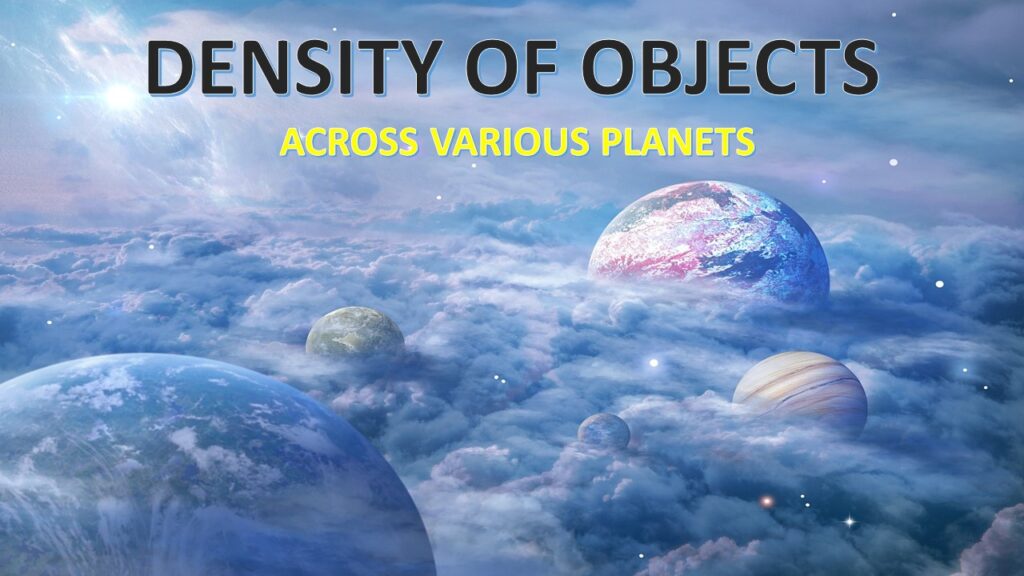Explore the diversity of densities across different planets, from rocky worlds to gas giants. Dive into fascinating scientific insights about the gravitational pull and mass distribution across celestial bodies. Learn how the density of objects impacts their formation and characteristics. Get ready for a mind-expanding journey through the cosmos
The exploration of celestial bodies, such as planets, is a fascinating field of study that reveals valuable insights into the mysteries of the universe. Among the many properties of planets, density plays a crucial role in understanding their composition and internal structure. In this article, we will delve into the concept of density, explore its significance in studying planets, compare the densities of different celestial objects, discuss density anomalies, and explore the techniques used to measure density. So, let’s embark on this journey to understand the density of objects across various planets!
1. Introduction
Density refers to the measure of how much mass is contained within a given volume. It is an essential physical property that helps us determine the composition and structure of objects, including planets. By analyzing the density of celestial bodies, scientists can uncover valuable information about their formation, internal processes, and even potential habitability.
2. What is Density?
Density can be defined as the mass per unit volume of a substance or object. It is calculated by dividing the mass of an object by its volume. The unit of density is typically grams per cubic centimeter (g/cm³) or kilograms per cubic meter (kg/m³). A higher density indicates that more mass is packed within a specific volume, while a lower density implies that the object has less mass in the same volume.
3. Importance of Density in Understanding Planets
Density serves as a fundamental property in understanding the composition and structure of planets. By knowing the density, scientists can gain insights into a planet’s core, mantle, and crust, as well as the distribution of different materials within them. This knowledge helps us understand the formation and evolution of planets, as well as their potential for supporting life.
4. Factors Affecting Density
The density of an object is influenced by various factors, including its composition, pressure, and temperature.
4.1 Composition
Different materials have different densities. For example, substances like iron and lead have higher densities compared to lighter elements such as hydrogen and helium. The overall composition of a planet, including the distribution of elements and compounds, plays a significant role in determining its density.
4.2 Pressure
Pressure affects the density of objects, especially in cases where high pressures compress the materials, leading to increased density. Planets with high internal pressures, such as gas giants like Saturn and Uranus, exhibit higher average densities due to the compression of their gaseous atmospheres.
4.3 Temperature
Temperature can also influence density. Generally, as substances heat up, their molecules move more rapidly, resulting in an expansion of volume and a decrease in density. Conversely, cooling substances can cause them to contract, leading to an increase in density. The temperature gradients within planets can impact their overall density distribution.
5. Comparing Density on Earth and Other Planets
Let’s explore the densities of different celestial objects, starting with our home planet Earth and then venturing out into the depths of space.
5.1 Earth
Earth, with an average density of approximately 5.52 grams per cubic centimeter (g/cm³), consists of various layers. The densest materials, such as iron and nickel, are concentrated in the core, while the less dense materials form the mantle and crust. The overall density of Earth provides clues about its composition and differentiation processes during its formation.
5.2 Mars
Mars, often referred to as the “Red Planet,” has an average density of around 3.93 g/cm³. Its lower density compared to Earth suggests that Mars has a higher concentration of lighter elements and minerals in its composition. This density difference also indicates that Mars lacks the extensive metallic core found in Earth.
5.3 Mercury
Mercury, the closest planet to the Sun, has a relatively high density of approximately 5.427 g/cm³. Its density suggests a significant presence of heavy elements like iron in its composition. Mercury’s high density is attributed to the immense pressure exerted by its gravity due to its proximity to the Sun.
5.4 Saturn
Saturn, known for its stunning rings, has a unique density. Despite being a gas giant primarily composed of hydrogen and helium, Saturn’s average density is only about 0.687 g/cm³. This low density is due to the planet’s massive size, which causes its materials to be spread out over a large volume, resulting in a relatively low mass-to-volume ratio.
5.5 Uranus
Uranus, another gas giant in our solar system, has a slightly higher density than Saturn. It has an average density of approximately 1.27 g/cm³. Uranus’s density is influenced by its composition, which includes a combination of hydrogen, helium, and other compounds. The presence of heavier elements within Uranus contributes to its slightly higher density compared to Saturn.
6. Density Anomalies
While the densities of most celestial objects follow predictable patterns, there are instances where anomalies occur. These density anomalies can provide valuable insights into unique geological and compositional characteristics.
For example, the moon Titan, one of Saturn’s moons, has a density lower than that of water. This anomaly suggests the presence of liquid hydrocarbon lakes on its surface, making it a fascinating object for further study.
7. The Significance of Density Variations
Studying density variations across planets helps scientists understand the complex processes that shape planetary bodies. Differences in density provide information about variations in composition, such as the distribution of rocks, metals, and gases. These density variations offer valuable clues about a planet’s history, formation, and geological activity.
8. Techniques Used to Measure Density
Scientists employ various techniques to measure the density of planets and other celestial bodies. These techniques include:
8.1 Mass and Volume Measurements
Measuring the mass and volume of an object allows scientists to calculate its density accurately. Mass is determined using instruments such as balances, while volume can be measured through displacement methods or geometric calculations.
8.2 Gravitational Methods
Gravitational methods involve studying the gravitational forces exerted by a planet on its surroundings. These measurements help determine the average density of the planet, as gravity is influenced by the mass and volume of the object.
8.3 Seismic Waves
Seismic waves generated by earthquakes or impact events can provide insights into a planet’s internal structure. By analyzing the propagation and behavior of seismic waves, scientists can estimate the density and composition of different layers within a planet.
9. Density and Exoplanet Studies
Density measurements have also revolutionized our understanding of exoplanets, which are planets outside our solar system. By studying the mass and size of exoplanets, scientists can estimate their average density. This information provides crucial insights into their composition, whether they are predominantly rocky, gaseous, or a combination of both.
The Kepler mission and other space observatories have discovered a wide range of exoplanets with diverse densities. Some exoplanets, known as “super-Earths,” have higher densities than Earth, suggesting the presence of denser materials like metals or heavier compounds. Others, called “mini-Neptunes,” have lower densities, indicating the presence of substantial gaseous atmospheres.
Understanding the density of exoplanets helps scientists classify them into different categories and refine theories of planetary formation and evolution. It also guides the search for potentially habitable worlds and provides insights into the prevalence and diversity of planetary systems in the universe.
10. Conclusion
Density serves as a critical parameter in understanding the composition, structure, and formation of planets. By analyzing the density of objects across various planets, scientists gain valuable insights into their internal processes and geological history. Factors such as composition, pressure, and temperature play crucial roles in determining the density of celestial bodies.
The comparison of densities between Earth and other planets highlights the diversity of planetary compositions and structures within our solar system. Density anomalies on certain objects provide unique opportunities for scientific exploration and investigation. Furthermore, advancements in techniques for measuring density, along with studies of exoplanets, contribute to our broader understanding of planetary science and the search for habitable worlds beyond our own.
FAQs
1. Can density alone determine if a planet can support life?
Ans. Density alone cannot determine if a planet can support life. Other factors, such as the presence of water, suitable atmospheric conditions, and the right combination of elements, are also crucial for habitability.
2. Are there any planets with densities similar to Earth?
Ans. Yes, several exoplanets have been discovered with densities similar to Earth, suggesting the potential for rocky compositions and possibly Earth-like conditions.
3. How do scientists measure the density of distant exoplanets?
Ans. Scientists measure the density of distant exoplanets by studying their mass and size. This information is obtained through observations using telescopes and other astronomical instruments.
4. Can density variations on a planet affect its gravitational pull?
Ans. Yes, density variations within a planet can affect its gravitational pull. Variations in mass distribution influence the gravitational field and can be detected by studying the orbits of satellites or spacecraft around the planet.
5. Are there any ongoing missions focused on studying the densities of planets?
Ans. Yes, several ongoing missions, such as NASA’s Juno mission to Jupiter and the upcoming ESA mission to study the planet Mercury (BepiColombo), aim to provide valuable data on the densities and compositions of these celestial bodies.

